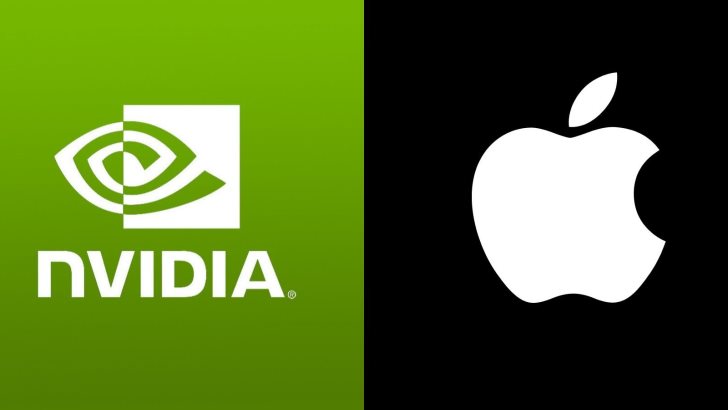
In a remarkable milestone for the tech industry, Nvidia has once again surpassed Apple to become the largest company in the world by market capitalization. With a market cap of $3,705.83 trillion, Nvidia narrowly edged out Apple’s $3,702.17 trillion, marking a major shift in the tech landscape. This transition highlights Nvidia’s dominance in the artificial intelligence (AI) sector, which has become one of the fastest-growing industries globally. The AI revolution has captured the imagination of investors, and Nvidia, as the leading provider of AI hardware solutions, has emerged as the crown jewel of the new technological frontier.
The financials of the two companies, however, tell an interesting story. In 2024, Apple reported an impressive $391.04 billion in revenue with a net profit of $93.74 billion. Apple’s financial strength is unparalleled in terms of profitability, backed by a loyal customer base, a robust ecosystem of hardware and services, and a global brand that is second to none. Nvidia, in comparison, reported much smaller figures, with $113.3 billion in revenue and a net income of $29.76 billion. Despite generating significantly less revenue and profit than Apple, Nvidia’s market valuation has skyrocketed, driven by the surging demand for AI chips that form the backbone of modern AI systems.
The AI Gold Rush: Nvidia’s Meteoric Rise
Nvidia’s success is primarily tied to its dominance in the AI sector, which is at the heart of its surging stock price. The company is known for its Graphics Processing Units (GPUs), originally developed for gaming but now essential for AI applications. Nvidia’s GPUs are the foundation of most machine learning and AI models today, as they allow for the parallel processing required to train large datasets. From training massive language models like OpenAI's GPT series to powering autonomous driving systems and medical research, Nvidia’s chips are indispensable.
The explosion of AI across industries—ranging from healthcare to automotive and finance—has fueled Nvidia’s rise to the top. AI is rapidly evolving into a transformative force, and companies, governments, and research institutions worldwide are racing to develop AI-driven solutions. Nvidia’s ability to provide the hardware infrastructure for this revolution has placed it in a unique and powerful position.
The market’s optimism about Nvidia’s future growth is evident in its valuation. Nvidia’s stock has seen a meteoric rise, with investors betting that the company will remain at the forefront of AI innovation. Its cutting-edge chips are in high demand, particularly as AI becomes more embedded in everyday technology, driving productivity and efficiency across sectors. But this rise has sparked a broader question: Is the market too aggressively pricing in the AI revolution into Nvidia’s stock?
The Valuation Debate: Too Much Too Soon?
While Nvidia’s market cap has surpassed Apple’s, some analysts are cautious about the sustainability of its growth trajectory. AI is undoubtedly a game-changer, but the speed at which Nvidia’s stock price has surged has led to concerns of overvaluation. With a price-to-earnings ratio that is significantly higher than many of its peers, Nvidia is being valued not just on current performance, but on the expectation of significant future growth. Investors are essentially betting that Nvidia will continue to dominate the AI hardware space for years to come.
The AI revolution is still in its early stages, and while demand for AI chips is currently skyrocketing, competition is heating up. Other tech giants, including Google, Microsoft, and Amazon, are investing heavily in developing their own AI solutions, and competitors in the semiconductor industry, such as AMD and Intel, are not far behind in the race to develop advanced AI hardware. If Nvidia’s lead narrows or if demand for AI chips does not grow as exponentially as expected, the company could face pressure to justify its high valuation.
Moreover, while Nvidia’s chips are critical to AI development, the software and applications that run on these chips are equally important. As AI becomes more mainstream, companies may develop more efficient AI systems that rely on fewer chips or new hardware solutions could emerge that challenge Nvidia’s dominance. This potential for technological disruption is a key risk factor.
Apple: The Tech Giant Remains a Powerhouse
Despite losing its crown as the largest company by market cap, Apple remains a tech juggernaut. Its revenue and profitability dwarf Nvidia’s, and it continues to generate steady, reliable growth. Apple’s core strength lies in its diversified ecosystem, which includes products like the iPhone, Mac, and Apple Watch, as well as its growing services business, which includes the App Store, Apple Music, iCloud, and Apple TV+.
In 2024, Apple generated $391.04 billion in revenue, with $93.74 billion in net profit—a level of profitability that is the envy of the industry. Apple’s brand loyalty and its seamless integration of hardware and software make it one of the most trusted and reliable consumer tech companies globally. The company’s ability to consistently innovate, with recent advancements in areas like augmented reality (AR) and healthcare technology, ensures that it remains a force to be reckoned with.
However, Apple’s growth is more incremental, whereas Nvidia is riding a wave of excitement around AI. Apple’s expansion into new areas, such as AR and autonomous systems, is still developing and will take time to materialize fully. Nonetheless, with its vast cash reserves and consistent profitability, Apple has the resources to invest in the next generation of technology, whether it’s AI, AR, or something else entirely.
What’s Next for Both Companies?
As Nvidia basks in the glow of its newfound status, the question is whether it can maintain its lead in the fast-evolving AI space. The company will need to continue innovating, as competition intensifies and the expectations from investors grow. Nvidia’s future growth hinges on the sustained expansion of AI applications and its ability to fend off emerging competitors.
For Apple, the road ahead is one of steady progress. While it may not generate the same headlines as Nvidia in the AI space, Apple’s diversified business model and focus on long-term innovation provide a solid foundation for continued success. The company is also making quiet moves in the AI world, particularly in areas like health and personal assistants, where its vast user base gives it a unique advantage.
In conclusion, Nvidia’s rise above Apple in market cap reflects the market’s belief in the transformative potential of AI, with Nvidia as the key enabler of that future. However, Apple’s strong financials and loyal customer base ensure that it remains one of the most powerful companies in the world. Both companies are charting different paths, but each has a vital role to play in the future of technology.




















